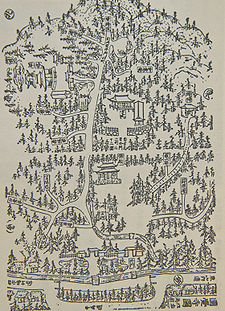
Shinpen Kamakurashi
Encyclopedia

Edo period
The , or , is a division of Japanese history which was ruled by the shoguns of the Tokugawa family, running from 1603 to 1868. The political entity of this period was the Tokugawa shogunate....
compendium of topographic, geographic and demographic data concerning the city of Kamakura
Kamakura, Kanagawa
is a city located in Kanagawa Prefecture, Japan, about south-south-west of Tokyo. It used to be also called .Although Kamakura proper is today rather small, it is often described in history books as a former de facto capital of Japan as the seat of the Shogunate and of the Regency during the...
, Kanagawa Prefecture
Kanagawa Prefecture
is a prefecture located in the southern Kantō region of Japan. The capital is Yokohama. Kanagawa is part of the Greater Tokyo Area.-History:The prefecture has some archaeological sites going back to the Jōmon period...
, Japan, and its vicinities. Consisting of eight volumes and commissioned in 1685 by Tokugawa Mitsukuni
Tokugawa Mitsukuni
or was a prominent daimyo who was known for his influence in the politics of the early Edo period. He was the third son of Tokugawa Yorifusa and succeeded him, becoming the second daimyo of the Mito domain....
to three vassals, it contains for example information about "Kamakura's Seven Entrances
Kamakura's Seven Entrances
The city of Kamakura, Kanagawa in Japan, is closed off on three sides by very steep hills and on the fourth by the sea: before the construction of several modern tunnels and roads, the so-called Seven Entrances , or were its main links to the rest of the world...
", "Kamakura's Ten Bridges" and "Kamakura's Ten Wells". It includes illustrations, maps, and information about temples, ruins and place names etymologies
Etymology
Etymology is the study of the history of words, their origins, and how their form and meaning have changed over time.For languages with a long written history, etymologists make use of texts in these languages and texts about the languages to gather knowledge about how words were used during...
not only about Kamakura, but also about Enoshima
Enoshima
is a small island, about 4 km in circumference, at the mouth of the Katase River, which flows into Sagami Bay in Japan. Part of the city of Fujisawa, it is linked to the Katase section of the same city on the mainland by a 600 meter-long bridge...
, Shichirigahama
Shichirigahama
is a beach near Kamakura, Kanagawa prefecture, Japan, which goes from Koyurigimisaki Cape, near Fujisawa, to Inamuragasaki Cape, west of Kamakura. Since one could enjoy a clear view of Mount Fuji and Enoshima from there, during the Edo period it was famous as a subject for ukiyo-e. For example,...
, Hayama and Kanazawa
Kanazawa-ku, Yokohama
is one of the 18 wards of the city of Yokohama in Kanagawa Prefecture, Japan. As of 2010, the ward had an estimated population of 209,565 and a density of 6,760 persons per km². The total area was 31.01 km². The ward symbol, established 1987, expresses the image of sea, waves, and a sea...
. The book created and popularized many of these "numbered" names, which were picked up by many subsequent tourist guides and became part of Kamakura's image. Each volume contains a day's worth of walking and is a real and effective guide to sightseeing. This makes the book a precious source of information to historians.
It is also the source of at least one Kamakura canard: it is often written that Kugyō
Kugyo
is the collective term for the very few most powerful men attached to the court of the Emperor of Japan in pre-Meiji eras. The kugyō was broadly divided into two groups: the , comprising the Chancellor of the Realm, the Minister of the Left, and the Minister of the Right; and the , comprising the...
, the Buddhist monk who in 1219 assassinated his uncle and shogun Minamoto no Sanetomo
Minamoto no Sanetomo
Minamoto no Sanetomo was the third shogun of the Kamakura shogunate Sanetomo was the second son of the founder of the Kamakura shogunate Minamoto no Yoritomo, his mother was Hōjō Masako, and his older brother was the second Kamakura shogun Minamoto no Yoriie.His childhood name was...
, on the night of the murder was hiding behind the great ginkgo tree next to Tsurugaoka Hachiman-gū's senior shrine, but the Azuma Kagami
Azuma Kagami
The , or "mirror of the east", is a Japanese medieval text that chronicles events of the Kamakura Shogunate from Minamoto no Yoritomo's rebellion against the Taira clan in Izokuni of 1180 to Munetaka Shinnō and his return to Kyoto in 1266...
, our main historic source on the event, simply says he came . The detail of the ginkgo tree first appears in the Shinpen Kamakurashi.
It is believed the book was compiled using as a base the , written in 1674 by Tokugawa Mitsukuni himself about Kamakura's famous places, shrines and temples. The book was written at Zuisen-ji
Zuisen-ji
is a Buddhist temple of the Rinzai sect in Nikaidō's near Kamakura, Japan. During the Muromachi period it was the family temple of the Ashikaga rulers of Kamakura : four of the five kubō are buried there in a private cemetery closed to the public and first kubō Ashikaga Motouji's is also known...
, a Zen
Zen
Zen is a school of Mahāyāna Buddhism founded by the Buddhist monk Bodhidharma. The word Zen is from the Japanese pronunciation of the Chinese word Chán , which in turn is derived from the Sanskrit word dhyāna, which can be approximately translated as "meditation" or "meditative state."Zen...
temple of the Engaku-ji
Engaku-ji
right|thumb|A stone carvingNot to be confused with Enryaku-ji in Kyoto., or Engaku-ji , is one of the most important Zen Buddhist temple complexes in Japan and is ranked second among Kamakura's Five Mountains. It is situated in the city of Kamakura, in Kanagawa prefecture to the south of Tokyo...
school in Kamakura by Kawai Tsunehisa, Matsumura Kiyoyuki and Rikiishi Tadakazu.
Bibliographical Data:

